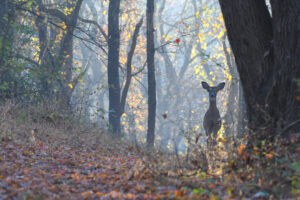Walk into the Center’s forest– or any forest in the region– and you’ll notice a habitat filled with invasive plants. The bright yellow flowers of lesser celandine, while beautiful, carpet the forest floor right now. Devil’s walking stick, every inch of it converted by thorns, are shooting up in massive clusters. Garlic mustard is in full flower, its leaves being munched on by the caterpillars of cabbage white butterflies, an invasive non-native butterfly– and often the first butterfly we see in the spring.
And that’s just the beginning, our forests overflowing with a veritable United Nations of Norway maple, English ivy, Japanese honeysuckle, and Oriental bittersweet, not to mention tree of heaven, cork tree, Norway spruce, knotweed, purple loosestrife, and on and on. Sadly, these invasives crowd out the native plants, contributing to the reduction in the biological diversity of the plants and animals of Pennsylvania forests.
In response, numerous environmental groups across the entire region, state, and country are working so hard to restore our forests, meadows and wetlands, engaging friends and volunteers in pulling out the invasives and replacing them with natives. Last week, we celebrated Earth Day by planting a number of native trees in an area we have christened the Earth Day Forest– and every year at Earth Day our stewardship efforts are focused here, planting native trees back in our landscape on this special day.
Worse, climate change and very hungry deer, not to mention new threats like lantern flies, conspire to undo all this hard, necessary work. The very trees we plant may get damaged by deer, and in a few decades the climate may warm so much that southeastern Pennsylvania might no longer be suitable for some of them.
So what do we do? What’s the path forward– if any? Join some of the region’s top restoration specialists in a lively conversation about the critical issue of restoring native habitats. The last in a spring series of Thursday Night Live virtual conversations, the “Restoration Roundtable: A Town Meeting” is set for Thursday, April 28 at 7:00 p.m. The free event is held over Zoom; register and receive the link.
The event’s guests include Gary Gimbert, Senior Director of Land Stewardship and Restoration Coordinator of Natural Lands, one of the region’s largest non-profit land trusts that manages thousands of acres of preserves across the area, Steve Goin, the Schuylkill Center’s Director of Land and Facilities and a certified arborist, Steve Jones, a board member with Wissahickon Restoration Volunteers, and Rebecca Kagle, managing principal with Larry Weaner Landscape Associates. Each of these people will share their restoration experiences– and most importantly, answer your questions about this important topic.
What’s the best native tree to plant in my yard? What do we do about deer over-browsing our forests? What will the impact of climate change be on our forests? How can more of us help? And the most interesting question perhaps of all: can any of us restore any forest to anything it might have ever looked like in its history? Our four guests will answer all of your questions about restoring native habitats while offering their organizations’ unique perspectives.
For the Center, this question is central to our land stewardship work. For the last 20 years, we have been actively engaged in a wide variety of restoration projects across our 340-acre forest, like putting up a deer fence to exclude those hungry animals from a 20-acre Wildflower Loop, giving spring wildflowers there a chance to flourish. We’ve planted several thousand trees, shrubs, and wildflowers throughout our forest in this time, desperately hoping a large number of them stick. Trouble is, we never know how many have– and we have to monitor them continuously.
So we have backed away from using the word “restoration” in our projects, and instead describe our work appropriately as “stewardship.” We are actively working– every day– to improve the land while acknowledging we’re not sure we can restore it to anything it ever looked like before.
At the same time, we’re also not willing to concede defeat, not willing to raise the white flag, not willing to pack our bags and go home. We are caretakers of a massive sweep of forest, and will doggedly strive to improve it while openly acknowledging it is an uphill slog. We’re rolling that boulder up a very large hill, fully aware it might crash down on us anytime.
So we soldier on. And will wrestle with our work openly on Thursday evening at our Restoration Roundtable, and invite you to wrestle with us. See you there.
By: Mike Weilbacher, Executive Director

